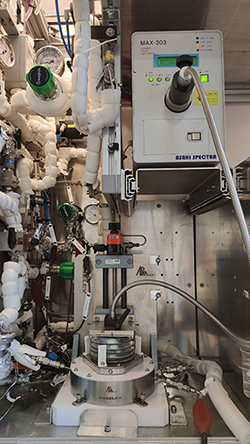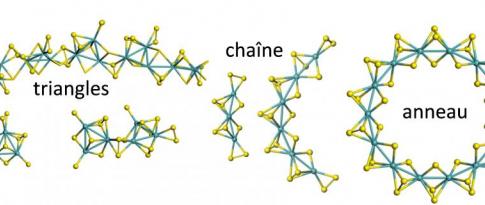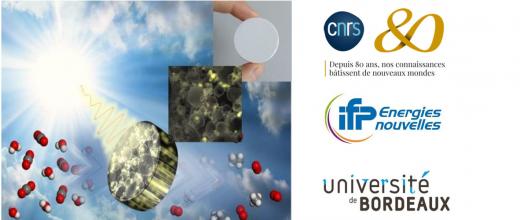With emissions from human activity crossing the threshold of 40 billion tons of CO2 per year, and despite half of the gas being captured by the oceans and land vegetation, in April 2021 its atmospheric concentration reached the unprecedented level of 420 ppm. Although the climate crisis makes the reduction of CO2 emissions a matter of urgency, some industries will have difficulty in avoiding them, such as cement plants (where the core process is currently based on the calcination of CaCO3) or refineries, which are currently highly energy-intensive. Hence the huge potential interest in procedures that could capture the CO2 released directly from the plant, where it is most concentrated (at several dozen percent), then recover it at a fraction of the energy cost.
One of the most effective ways of doing this is inspired by photosynthesis and involves converting the CO2 into valuable molecules with the help of the sun’s plentiful and renewable photon energy.
With this in mind, IFPEN is working on the development of a technology that could be fitted to plant exhaust chimneys, or directly to the process exhaust, which uses photocatalysis to treat an effluent that is rich in CO2 (combustion, reaction gases, etc.) but also in H2O. The target process is based on the use of solid photocatalysts that operate in gas phase, thereby removing the need for any solvent or sacrificial moleculea. As an example, it would allow the photoreduction of CO2 into chemical intermediates, such as carbon monoxide (CO), methane (CH4) or even ethane (C2H6).
The division’s historic effort in this area was recently recognized with the award of the 2021 IMT-Académie des Sciences Young Scientist Prize to Antoine Fécant, a pioneer in the subject at IFPEN.
Currently, four key areas are being worked on simultaneously:
- The development of new solids [1,2] which, thanks to their semi-conductive and catalytic properties, will make it possible to achieve the desired conversion. These efforts are being carried out as part of thesis projects in collaboration with ITQ Valenceb on the development of new sulphur-containing zeolites, and with ETH Zurichc on the development of new transition metal oxysulphides.
- The modelling and prediction of the opto-electronic properties of different solids [3] to assist in the selection of the most promising materials, as part of the ROAD4CAT chair, in partnership with ENS Lyon.
- The development of in operando analyses in collaboration with LCS Caend, in order to identify charge carrierse and reaction intermediates, with the aim of identifying the reaction mechanisms of the photoreduction of CO2.
- The design of an effective photoreactor that would make it possible to minimize the footprint of the process.
Click on the picture to enlarge

In addition to doctoral theses, IFPEN is involved in this topic through joint projects, such as:
- at national level in France, in the ANR PMCOCAT project, coordinated by the Institut Lavoisier de Versailles, which was launched in 2022, and for which IFPEN will conduct testing on new composite materials with strong potential for CO2 reduction;
- at European level (Horizon 2020 programme), in the SUN2CHEM project, which started in 2020 and brings together 15 partners around the Ecole Polytechnique Fédérale de Lausanne, for which IFPEN will perform life cycle analyses (LCA) of processes aimed at the photo(electro)reduction of CO2.
After more than a decade of research on photocatalysis, IFPEN has filed some thirty patents in this area, in particular relating to promising materials such as 3D photonic sponges, which should provide a solution to the challenge of reducing the footprint of CO2 photoconversion processes.
Furthermore, in 2021, IFPEN developed a new research facility for photo-conversion (figure), the only one of its kind in France, thanks to a broad range of parameters that make it possible to adjust variables, such as temperature, pressure, gas flows, irradiation wavelength, radiation output, etc. This tool can be made available to any laboratory wanting to test new materials of interest for the target application.
a- Proton Donor
b- Thesis by Beatriz Silva-Gaspar (2019-2022)
c- Thesis by Sébastien Roth (2021-2024)
d- Thesis by Joudy Dankar (2020-2023)
e- Electrons or holes
References:
- “Bulk Photo-Driven CO2 Conversion through TiO2@Si(HIPE) Monolithic Macrocellular Foams”, S. Bernadet, E. Tavernier, D.-M. Ta, R. Vallée, S. Ravaine, A. Fécant, R. Backov. Advanced Functional Materials. Volume 29, Issue 9, 2019, 1807767.
>> https://doi.org/10.1002/adfm.201807767
- “Plasmonic photocatalysis applied to solar fuels”, S. Bardey, A. Bonduelle-Skrzypczak, A. Fécant, Z. Cui, C. Colbeau-Justin, V. Caps, V. Keller. Faraday Discuss., 2019, 214, 417-439.
>> https://doi.org/10.1039/C8FD00144H
- “2D MoO3-xSx/MoS2 Van Der Waals Assembly: A Tunable Heterojunction with Attractive Properties for Photocatalysis”, M. Shahrokhi, P. Raybaud, T. Le Bahers, ACS Appl. Mater. Interfaces 2021, 13, 36465-36474.
>> https://doi.org/10.1021/acsami.1c08200
Scientific contact: Audrey Bonduelle
You may also be interested in
The ROAD4CAT chair one year in
The 1st industrial chair within the IdexLyon projecta, ROAD4CAT (RatiOnAl Design for CATalysis), launched in June 2018, brings together IFPEN and the Chemistr







